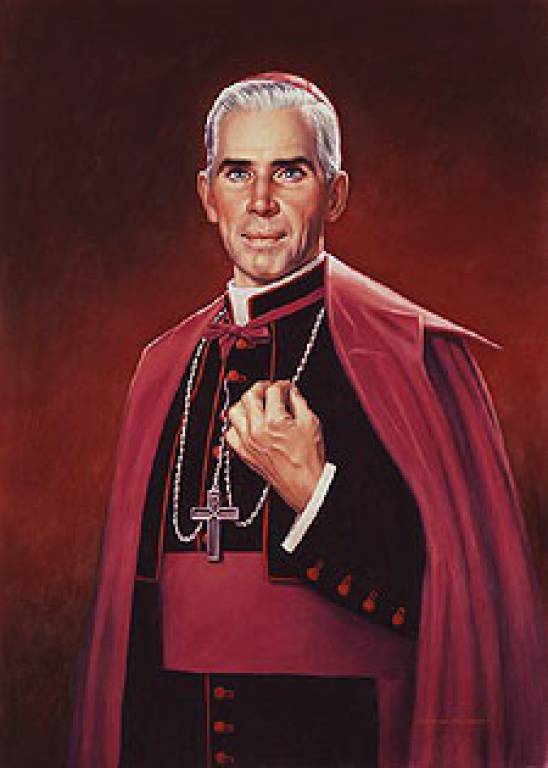Biography of Archbishop Fulton J. Sheen
Peter John Sheen was born in El Paso, Illinois, the oldest of four sons of Newton and Delia. Though he was known as Fulton, his mother's maiden name, he was baptized as Peter John Sheen. His first role in the Church was as an altar boy at St. Mary's Cathedral. After high school and college, Sheen attended Saint Paul Seminary in Minnesota before his ordination on September 20, 1919, then followed that with further studies at The Catholic University of America in Washington, D.C. His youthful appearance was still evident on one occasion when a local priest asked Sheen to assist as altar boy during the celebration of the Mass.
Sheen earned a doctorate in philosophy in 1923 at Belgium’s Catholic University of Leuven. In 1926 Bishop Edmund Dunne of the Roman Catholic Diocese of Peoria, Illinois asked Sheen to take over St. Patrick's Parish. After nine months, Dunne returned him to Catholic University, where he taught philosophy until 1950.
A popular instructor, Sheen wrote the first of many books in 1925, and in 1930 began a weekly Sunday night radio broadcast, The Catholic Hour. Sheen called WWII not only a political struggle, but also a "theological one." He referred to Hitler as an example of the "Anti-Christ." Two decades later, the broadcast had a weekly listening audience of four million people. Time referred to him in 1946 as "the golden-voiced Msgr. Fulton J. Sheen, U.S. Catholicism's famed proselytizer" and reported that his radio broadcast received 3,000–6,000 letters weekly from listeners.
During the middle of this era, he conducted the first religious service broadcast on the new medium of television, putting in motion a new avenue for his religious pursuits. In 1951 he began a weekly television program titled “Life Is Worth Living.” Filmed at the Adelphi Theatre here in New York City, the program consisted of the unpaid Sheen simply speaking in front of a live audience without a script or cue cards, occasionally using a chalkboard.
The show, scheduled in a graveyard slot on Tuesday nights at 8:00 p.m., was not expected to challenge the ratings giants but did incredibly well. Life and Time magazine ran feature stories on the then Bishop Sheen. The number of stations carrying “Life Is Worth Living” jumped from three to fifteen in less than two months. There was fan mail that flowed in at a rate of 8,500 letters per week. There were four times as many requests for tickets than could be fulfilled. In 1952, Sheen won an Emmy Award for his efforts, accepting the acknowledgment by saying, "I feel it is time I pay tribute to my four writers—Matthew, Mark, Luke and John." Time magazine called him "the first 'televangelist'", and the Archdiocese of New York could not meet the demand for tickets.
He was consecrated a bishop on June 11, 1951, and served as an Auxiliary Bishop of the Archdiocese of New York from 1951 to 1965. Yet, the show ran until 1957, drawing as many as 30 million people on a weekly basis. In 1958, Sheen became national director of the Society for the Propagation of the Faith, serving for eight years before being appointed Bishop of Rochester, New York, on October 26, 1966.
He also hosted a nationally-syndicated series, The Fulton Sheen Program, from 1961 to 1968 (first in black and white and then in color). The format of this series was essentially the same as “Life Is Worth Living.” Sheen was credited with helping convert a number of notable figures to the Catholic faith, including agnostic writer Heywood Broun, politician Clare Boothe Luce, automaker Henry Ford II, Communist writer Louis F. Budenz, theatrical designer Jo Mielziner, violinist and composer Fritz Kreisler, and actress Virginia Mayo. Each conversion process took an average of 25 hours of lessons, and reportedly more than 95% of his students in private instruction were baptized.
On October 15, 1969, one month after celebrating his 50th anniversary as a priest, Sheen resigned from his position and was then appointed Archbishop of the Titular See of Newport (Wales) by Pope Paul VI. This ceremonial position allowed Sheen to continue his extensive writing. Archbishop Sheen wrote 73 books and numerous articles and columns.
On October 2, 1979, two months before Sheen's death, Pope John Paul II visited St. Patrick's Cathedral in New York City and embraced Sheen, saying, "You have written and spoken well of the Lord Jesus Christ. You are a loyal son of the Church."
Sheen died of heart disease on December 9, 1979, having previously had open-heart surgery at Lenox Hill Hospital. He is buried in the crypt of St. Patrick's Cathedral, near the deceased Archbishops of New York. The official repository of Sheen's papers, television programs, and other materials is at St. Bernard's School of Theology and Ministry in Rochester, New York.
Sheen was declared Venerable Servant of God by Pope Benedict XVI on July 28th 2012.
From the website of St. Malachy's Church, New York City, The Actors' Chapel
Prayer for Canonization
Heavenly Father, source of all holiness, You raise up within the Church in every age men and women who serve with heroic love and dedication. You have blessed Your Church through the life and ministry of Your faithful servant, ARCHBISHOP FULTON J. SHEEN. He has written and spoken well of Your Divine Son, Jesus Christ, and was a true instrument of the Holy Spirit in touching the hearts of countless people. If it be according to Your Will, for the glory of the Most Holy Trinity and for the salvation of souls, we ask You to move the Church to proclaim him a saint.
We ask this prayer through Jesus Christ, our Lord.
Amen.
Imprimatur:
+ Most Reverend Daniel R. Jenky, C.S.C., Bishop of Peoria
